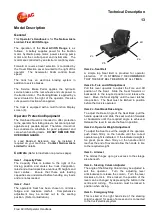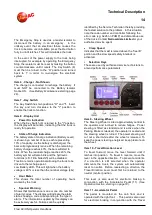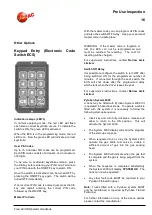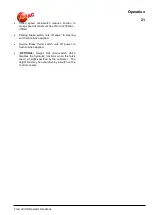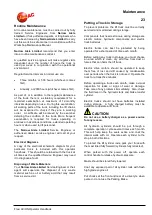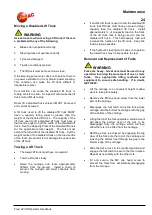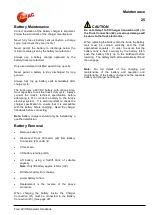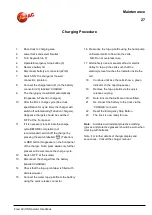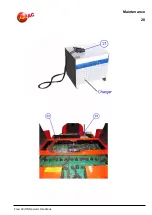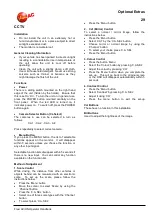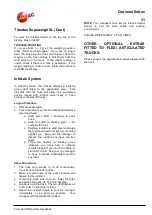
Operation
19
Flexi ACiON Operator Handbook
Downhill slope
When travelling down the slope use the right foot to
apply the Service Brake Pedal and so control the
speed. The speed will also be controlled by the
control system.
Turning in a Narrow Aisle
Drive the truck down the aisle. Identify the load
location and position the truck to the opposite side of
the aisle leaving a clearance from the racking of
about 125mm at the front wheels and 150mm at the
rear wheels. The truck should now be alongside
chosen pallet with steering straight. Position the front
wheel opposite the centre line of the chosen pallet
stack. Turn the steering wheel to full lock. The
footbrake or handbrake should not be applied. The
forks are now in line for entering the pallet. Reverse
the procedure to straighten the truck to proceed
along the aisle.
Loading
WARNING
Do not exceed the rated capacity of the truck as
overloading can cause truck instability. If in doubt,
check with Capacity Plate (1).
Loads which are to be transported and placed in
storage must be securely packaged. This ensures
that the centre of gravity does not move during
loading and that no small parts are able to drop out.
When manoeuvering to pick up a load, avoid erratic
movements that could result in damage to the load or
the truck.
Always approach the load with the centre line of the
truck in line with the load.
Apply Parking Brake, raise load 150mm to 200mm
above ground level and tilt the mast back to stabilise
if required.
When picking up a load, ensure that it is centrally
positioned on the forks and that the forks are inserted
as far under the load as possible. The pallet/load
should contact the vertical face of the forks.
When carrying a load always travel with the mast and
fork carriage in the correct travelling position i.e. Mast
fully tilted back and the lowest point of the forks or
load approximately 150mm to 200mm above the
ground.
Note that the truck is designed to be operated as a
means of transporting and handling goods. Thus
lifting operations should form no more than 20% of
the operating cycle. Failure to observe this may result
in overheating of the hydraulic system.
Stacking / De-stacking
There are two methods of stacking/de-stacking loads.
The relationship between the aisle width and the load
size will determine which of the two methods should
be used.
Stacking
•
Pick up the load as described in
Loading (this
page)
. Drive down the aisle and position the
truck as described in
Turning in a Narrow Aisle
(this page).
•
Apply the Parking Brake and reduce the back tilt
to an amount sufficient to stabilise the load.
•
Raise the load to the required height for
stacking.
•
When the load is clear of the chosen rack beam,
release the Parking Brake and move slowly
forward and at the same time smoothly turn the
Steering Wheel to keep the load parallel to the
rack end frame.
•
When the load is over the rack, stop and apply
the Parking Brake.
•
Bring the mast to the vertical position and lower
the load onto the rack.
•
Release the Parking Brake and slowly reverse,
at the same time turning the Steering Wheel to
keep the forks perpendicular to the rack, until
the forks are clear.
•
Apply
the Parking Brake, lower the forks
carefully to the travel position, and then tilt the
mast back.
•
Release the Parking Brake and move off. (See
Turning in a Narrow Aisle, this page).
De-stacking
•
Drive the truck down the aisle and position the in
line with the pallet as described in
Turning in a
Narrow Aisle (this page)
and apply Parking
Brake.
•
Bring the mast to the vertical position and raise
the forks to a height that will allow clear entry
into the pallet. Release the Parking Brake.
•
Insert the forks by slowly driving forward and at
the same time smoothly turning the Steering
Wheel so as to keep the forks parallel with the
pallet. Apply the Parking Brake.
•
Lift the load until clear of the rack and carefully
apply sufficient backward tilt to stabilise the load.
•
Release the Parking Brake, slowly reverse and
at the same time turn the Steering Wheel to
keep the load square with the racks. Take care
not to dislodge adjacent loads.
Summary of Contents for Flexi ACiON 1000
Page 1: ...Issue A 25 6 2019 Flexi ACiON Operator Handbook VNA 1000 1100 1200 1250 1350 1400...
Page 5: ...Technical Specification 1A Flexi AC Operator Handbook...
Page 7: ...Technical Specification 3 Flexi ACiON Operator Handbook Dimensions...
Page 16: ...Technical Description 12 Flexi ACiON Operator Handbook Controls Etc...









